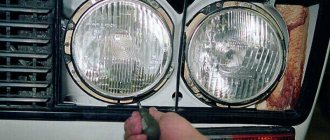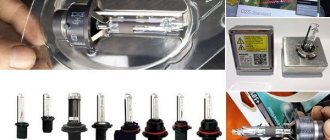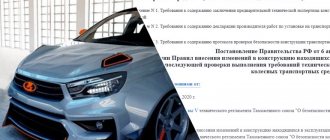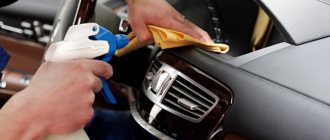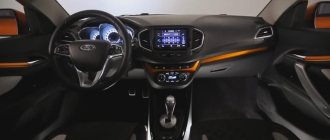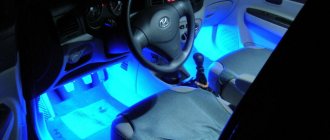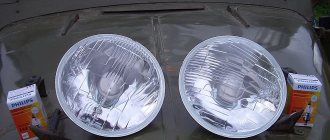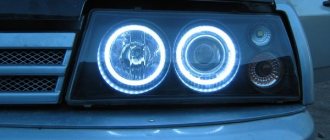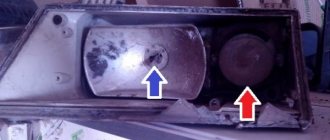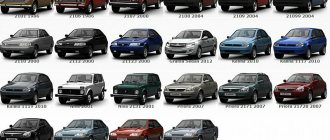Auto engineers and many car owners are trying to improve the quality of headlights in various ways. One of the most effective ways to solve this problem is to install gas-discharge light sources or xenon lamps. Moreover, if the former do this on an industrial scale with all the necessary measurements and tests, then the latter install xenon in makeshift conditions, without thinking about the technical side of the matter.
Often the only question homegrown Kulibins ask is:
- What is the difference between xenon and bi-xenon?
- what temperature of the lamp to set.
Undoubtedly, headlights with gas-discharge lamps shine much better than conventional halogen lamps, but they must be “correct”. Otherwise, all that can be achieved is bright lighting five meters in front of the car and severe blinding of oncoming drivers.
Types of xenon lamps.
Types of bases for xenon light sources.
Depending on the purpose, there are three types of different bases: H, HB and D.
Based on their design, there are spherical, tubular and ceramic light sources.
Ball xenon lamps are small, the bulb is in the shape of a ball. Distinctive features are the small size of the luminous area and high brightness of the light.
The electrodes are located at a minimum distance from each other: 3-6 mm or 0.3-2.5 mm for special-purpose lamps. The power of ball light sources reaches 7 kW.
According to Russian standards, ball lamps are designated as DKsSh (arc xenon ball).
This type of light source is widely used for car headlights.
Ceramic light sources are distinguished by the presence of a ceramic bulb in which holes are made for the passage of ultraviolet radiation. They are used in medicine and pharmaceuticals for disinfection.
Tubular CDLs contain a flask in the form of a tube of different lengths and diameters. The electrodes can be located at a considerable distance from each other. According to Russian standards, they are designated as DKsT (arc xenon tubular). The power of such lamps is in the range of 2 W - 50 kW.
For the correct and safe use of tubular xenon lamps, current limiting devices are required, which are built into the electrical circuit. This type of light source is used for external and internal lighting of large areas and objects.
In addition, there is a division of CDL into the following types:
- long-term use with a short arc (similar to xenon headlight lamps);
- long-term use with a long arc (similar to tubular);
- flash lamps (with an additional third electrode for ignition).
There are also lamps operating on direct and alternating current.
Other colors
How to choose h4 LED lamps
As stated above, the shade cast by xenon headlights depends on the temperature inside the bulb. Let's look at what it comes in and how xenon of different colors is used.
| Temperature | Color | Application |
| 3500 Kelvin | Yellow | This temperature is lower than daylight temperature and is therefore not suitable for ordinary lighting. Such lamps are used only in PTF. |
| 4300 Kelvin | White-yellow | It is considered the brightest and most comfortable for humans. This is what is most often installed in standard xenon. It is installed in the headlights. Experts do not recommend using it in PTF, as it will interfere with drivers of oncoming cars. |
| 5000 Kelvin | White | Such lamps create a bright, but rather cold light. The loss of brightness compared to standard xenon is about 100 lumens. It is recommended to use it only in headlights. |
| 6000 Kelvin | White-blue | It is this shade that most car enthusiasts prefer because of the visual effectiveness of the lighting. The light is bright with a slight blue tint. Loss of brightness compared to standard xenon is 200–300 lumens. It is recommended to install it only in headlights. |
| 7000 Kelvin | Blue | This shade is higher than the natural temperature of daylight, so the human eye perceives it poorly. The illumination level is slightly worse than that of halogen lamps. Not recommended for use in vehicle lighting. |
| 8000–12000 Kelvin | blue-blue to blue | It creates a glow that is difficult for the human eye. The illumination level is significantly lower than that of conventional halogen lamps. It is not used in lighting devices, but is used to create special lighting inside the interiors of limousines, party buses, etc. |
| 13000–15000 Kelvin | Violet | Creates a heavy, dim light. It is not used in lighting devices, but is used for interior lighting of limousines, party buses, etc. |
How to improve foglights: xenon instead of halogen lamps
As a rule, modern cars are standardly equipped with a whole range of modern lighting equipment: diodes, DRLs, adaptive xenon in the lens, etc. Non-standard modifications are also common when the owner installs xenon headlights in combination with xenon fog lights.
In this case, the installation of xenon in the PTF is often done incorrectly. As a result, the quality of road lighting does not improve and other drivers are blinded, although a car with xenon in PTF gets a more impressive appearance. For this reason, it is important to decide why the owner needs xenon in fog lights, and also to know how to install xenon in fog lights to replace conventional lamps correctly.
- First of all, fog lights should improve illumination when driving in fog.
- If the main goal is to improve the appearance, then it is easier and cheaper to install diodes or DRLs;
We also add that it will not be possible to achieve a significant improvement in appearance and at the same time implement high-quality road lighting using xenon in PTF. Moreover, installing xenon in fog lights is completely prohibited by traffic rules, since this is an illegal modification to the design of the vehicle.
However, with the right approach, you can achieve a result when xenon in fog lights will not blind oncoming drivers, and will not attract the attention of traffic police officers. Let's figure it out.
Why might xenon of a different color turn yellow?
Replacing a low beam lamp on a Chevrolet Niva
Some car enthusiasts who use gas-discharge light sources with a temperature of 4.3 to 6 thousand Kelvin are faced with the fact that over time one of the headlights or foglights begins to cast a yellow luminous flux.
The main reasons for such breakdowns include:
- Discharge lamp malfunction. When used in it, one of the electrodes may fail. This happens by combustion. The end of the electrode melts, forming a metallic deposit that settles at the bottom of the gas flask. The color of the electric arc, reflected from the metal, begins to look yellow, and its brightness significantly decreases.
- Problems with wiring. If a gap appears in the wiring, the electrical impulse becomes inhomogeneous, which can cause the color of the headlights to change and the lighting level to drop.
- Deterioration of lens transparency. This can happen for two reasons: lack of tightness and the use of low-quality lenses. The first problem is caused by an illiterate installation. If the technician made a mistake when installing the xenon, moisture may get into the gas flask, causing the color of the light flux to be distorted. The second reason is the use of a low-quality plastic lens, which, under the influence of temperature, begins to melt over time, thereby also changing the color of the lighting.
- Damage to one of the parts of the ignition unit. Diodes, transformers or capacitors may fail.
- Replacing only one of the lamps. If one of the gas-discharge lamps fails, two headlights must be replaced. During long-term operation under the influence of temperature, the color of the light flux changes due to melting of the electrodes. Therefore, by replacing only one of the lamps, you can notice a clear difference in the color of the luminous flux between the new and old xenon.
In the event of these malfunctions, the color of the xenon headlights may become not only yellow, but also purple, red, pink and blue.
Bought from us today
What is the difference between Xenon and Bi-Xenon?
The Xenon kit is Low Beam only. The distant one remains halogen. Bi-Xenon is both low and high beam, combined in one (usually a telescopic lamp). Depending on the car (or rather, on the base of the lamps installed in it), you may need to install two sets of xenon rather than one set of Bi-Xenon. (if you want xenon for low and high beam).
What do I need to know to buy xenon?
You need to know the lamp base as well as the desired xenon color temperature.
How can I find out what bulb base I have in my headlights?
You can remove the bulb from the headlight and look at the markings on the bulb itself. You can also call your dealer and request information about the lamp base from specialists, or look in the catalog for the selection of lamps by car brand, or look at the information on the glass and headlight housing.
When you turn it on, a blue color appears for 1-2 seconds, what is it, is everything normal?
The lamp turns on in 3 stages:
- it works like xenon and shines blue,
- as it heats up, the mercury evaporates and turns white,
- with further heating, color-forming metal salts evaporate and it reaches operating mode in terms of brightness and color.
Where can you put xenon light - only in the low beam?
Xenon can be installed in both low beam and high beam, low and high beam at the same time, as well as in fog lights and even in reversing lights.
I installed xenon, but after some time one headlight stopped shining, what should I do?
First, you need to figure out what exactly might be faulty: the car’s standard wiring, the ignition unit or the xenon lamp? In order to determine the cause of the malfunction, start with something simple - swap the xenon lamps in the headlights. If during such a rearrangement the fault “moves” to another headlight, then the lamp is faulty. If the same headlight still does not shine, swap the ignition units. If the rearrangement gives a result, the ignition unit is most likely faulty. If to no avail, then you need to check the car's wiring.
Can I install the xenon kit purchased from you myself?
Yes you can. Installing xenon is simple and does not require supernatural skills and knowledge from the installer. The website has installation instructions, and they will also advise you upon purchase if you have any questions!
Are the ignition units different for lamps with different color temperatures?
No, the ignition units for all lamps are the same, except that different manufacturers use different connectors.
What is the difference between D2S and D2R lamps?
- D2S - for headlights with lensed optics
- D2R - for reflector headlight without lens
Are there Philips lamps with base H1, H4, H7, 9005, 9006, 9007, etc.?
Yes they exist. Philips flasks are sealed in Korea. Base H1, H4, H7, 9005, 9006, 9007. Color temperature gradation 4300, 5000, 6000K. The luminous flux ranges from 2600-3200 Lm.
What color temperature do cars leave the assembly line with?
Philips, Osram, Hella 4200K-4800K lamps are usually installed on the conveyor.
The cost of lamps is different for everyone, Chinese and Korean ones cost 400/800 rubles, Philips and O cram almost 2000 rubles. What is the significant difference?
Lamps from well-known manufacturers always cost an order of magnitude more, they use higher quality materials and consistently good workmanship, the service life is usually at least three years, cheap lamps have a slightly shorter resource and less stability in quality, as a result of which their service life ranges from one to three years.
Does a xenon lamp get very hot?
A xenon lamp heats up much less than a halogen lamp. So, with a power consumption of 35 W, xenon uses about 7% of its energy as heat, while a halogen lamp, with a consumption of at least 55 W, uses about 40% of its energy as heat.
What is the power consumption of HID lamps (xenon lamps)?
A xenon lamp consumes 35W, a regular lamp consumes 55W or more. The luminous flux provided by xenon is 3,000 lumens versus 1,550 for a standard 55W halogen lamp.
What is the average lifespan of xenon lamps?
The average service life of H7 xenon lamps is about 2,800 - 4,000 hours. The guaranteed service life of halogen lamps is 100 - 500 hours.
How do Russian roads handle xenon headlights?
High vibration resistance is ensured by the absence of a filament.
There is no thread - there is nothing to break.
Is visibility really better with xenon lighting?
Yes, better. We all know how important visibility is in the dark, rainy, foggy or snowy weather. The light emitted by a xenon lamp, having 2.5 times greater intensity than usual, significantly helps the driver improve visibility of the road. The geometry of the illuminated section of the road is also improved, since the beam of light from a headlight equipped with a xenon lamp is wider. It is also important that “xenon” light, due to the peculiarity of its spectral composition, allows the driver to see objects located on the roadway and roadsides, such as road signs, at a much greater distance and much earlier.
Is visibility really better with xenon lighting?
Isn't the bright xenon light reflected from snow and rain blinding?
Even in rain and fog, xenon headlights do not create a “wall of light” in front of your eyes. Beams of xenon light easily “pierce” the fog and illuminate not drops of rain or fog, but the road surface.
Everyone praises xenon headlights, but do they have any disadvantages?
The disadvantages of xenon headlights are relative. There are two obvious disadvantages:
1. Expensive. In addition to the high cost of the lamp, one must keep in mind the following: when replacing xenon lamps, it is better to change them in pairs, since over time (all lamps turn white after about 200 hours of operation), the emission spectrum of the xenon lamp changes.
2. The need for a special control unit. First you need to apply a voltage of about 25,000 volts to the lamp, and then maintain 80 volts with a frequency of 300 Hz, for this you use devices called ignition units, ignition units or ballast units.
I've heard that there is fake xenon, how can you tell it apart from the real thing?
Yes, there are a number of lamps that are called “pseudo-xenon”. The fact is that many car enthusiasts are enchanted by the bluish light of xenon headlights. Manufacturers, aware of this state of affairs, began producing conventional halogen incandescent lamps, which create just such a bluish, or simply brighter, white glow. This is achieved by coating the flask with bluish dyes and increasing power consumption. In the first case, the illumination of the road at night is even worse than when using a simple lamp, and in the second, the headlight gets very hot, and when water gets in, its glass often breaks. Attempts to bring the emission spectrum of halogen lamps closer to gas-discharge (xenon) lamps are made not only by nameless companies from China and Korea, but also by eminent companies like Philips with their Blue Vision, Osram, PIAA, etc. It is not possible to achieve the same indicators of spectral composition and luminous flux based on an incandescent filament.
Will I be able to remove the xenon and install standard lamps in the headlights when selling the car?
Yes, this can be done without problems.
How do xenon installation kits sold in stores differ from those installed by official dealers?
Nothing in principle. Only the cost of xenon and installation.
Will I be able to pass technical inspection with xenon?
You can always replace xenon lamps with halogen ones (takes about 10-15 minutes) and pass technical inspection without any problems, and then return the xenon lamps to their place.
What is light temperature and why is this indicator so important?
Light temperature is the temperature at the surface of a light source. For example, in the Sun it is somewhere around 5,000 - 6,000 degrees on the Kelvin scale, in a halogen lamp this temperature is about 2,800 K. If we consider gas-discharge lamps (popularly xenon), then they have a light temperature of 4,000 K and higher.
As a rule, the assembly line uses lamps with 5,200 K (D2S Osram), although some cars in factories are equipped with Philips lamps (which do not come higher than 4,250 K). But due to the large difference in price, lamps with temperatures above 5,000 K, specifically from German manufacturers, are not widely used in our country. But the range of Korean lamps with temperatures up to 15,000 K is fully represented.
As the light temperature increases, the lamp light becomes increasingly brighter, whiter, and its shades shift from yellowish-red for lamps with a temperature of 4,000 K to bluish for lamps with a temperature of 7,000 K.
I have H4 bulbs on my car. Which xenon lamps should I choose?
Most often they put:
- Korean lamps with a ready-made H4 base and curtain.
- D2S via adapter.
What is the difference between motoxenon and regular xenon?
Nothing. Moto-xenon is a kit for installation on a motorcycle, i.e. one lamp and one ignition unit, which is half of a regular car xenon kit.
My bike has very little free space under the plastic fairings. Can I have problems installing xenon?
If there is a shortage of free space under the fairings of your motorcycle, we recommend using Silverstar , which are 2 times thinner than blocks from other manufacturers. With such a set of problems in placing the ignition unit and wiring should not arise even in the most limited space.
Is it true that xenon heats up more than standard halogen lamps?
Xenon heats up less than halogen incandescent lamps, so the headlight optics suffer less from high temperatures.
Bi-xenon is very afraid of vibrations and is not recommended for installation on scooters?
Vibrations on a scooter or motorcycle are not much different from those on cars. In addition, much more shaking is caused by the characteristics of the road surface, and not by the operation of the engine. Bi-xenon, like regular xenon, works without problems on both motorcycles and scooters.
What are the technical characteristics of xenon ignition units?
Typical parameters of all ignition units are approximately the following:
- Current in the circuit at the moment the lamps start: 10-15A, in operating mode: ~3.2A
- Permissible voltage range: 9-16V
- Ballasts: 9-32V
Protection:
- from voltage drop below 5±1V
- from a voltage surge above 28±1V
- from open circuit
- from short circuit
- from reversed polarity
Operating conditions: -30°С~+85°C Storage conditions: -30°С~+105°C
How to choose the right color temperature for xenon lamps? What is the optimal temperature?
When choosing the temperature of a xenon lamp, you need to keep in mind that the most optimal temperature for the human eye is 4500-5500 K. In addition, in addition to aesthetic considerations, it should be taken into account that the higher the color temperature, the less effective xenon light is.
How to choose the right color temperature for xenon lamps?
Do the colors of the lamps change over time?
The nominal temperature of a xenon lamp is actually an average value. After 100-500 hours of operation, a change in the color temperature of the light may be observed - the color “moves” towards a shorter wavelength (towards blue). This change is very slow, and, unless you specifically pay attention, barely noticeable. The amount of offset varies depending on the brand, model, and original rating. For Philips and Osram lamps with a rating of 4100K, after 500 hours of operation there is a natural “color shift” of about 250K, i.e. the color temperature will already be 4350K.
Why do xenon headlights irritate some oncoming drivers?
Under normal conditions, the driver looks at the road straight ahead. But because the light of xenon lamps stands out from the crowd, drivers of oncoming cars are more likely to study the headlights of cars that have xenon HID systems installed. A similar phenomenon accompanied the introduction of halogen lamps in the sixties. At the time, drivers spoke of "annoying white lights."
I want to install xenon on a scooter. Is this possible? I can’t find xenon anywhere with the lamp socket I need for my scooter/motorcycle. What should I do?
The lamp sockets of most scooters (especially 50cc) do not meet any automotive standards to which xenon lamps are manufactured. In this case, there is only one way out - buy a lamp with a base close in size to the standard one, and fix the lamp in the reflector using various devices and tricks.
In order to select a lamp base that is optimally close in size to a standard halogen lamp, we suggest you familiarize yourself with several photographs of most of the main types of automotive bases:
Automotive socket types S(HB), SH
Automotive socket types
Automotive socket types H, D2S, HB
We draw your attention to the fact that if the lamp has mechanical damage to both the bulb and the base, the seller will not bear any warranty obligations.
Are the connectors of the lamps and blocks the same?
Different manufacturers have different plugs = connectors = connectors, for example, from the common ones:
- Ket-02 on Sho-mi blocks and lamps
- Ket-01 on xenon equipment from MTF
- Us - 01 on Iltrade, etc.
Connectors for lamps and units
Will I lose the warranty on the car from the official dealer?
Installation centers are certified to carry out such work. All equipment also has PCT certificates (compliance with GOST standards). Thus, the official dealer has no legal grounds for revoking the car’s warranty! The same is true for the self-installation option; anyone can connect three wires!
What does the HID prefix mean in the name of xenon kits?
The prefix HID stands for High Intensity Discharge. These words speak about the principle of operation of the lamp.
They say that 6000-8000K lamps fail more often than 4300-5000K lamps. What is the problem?
Apparently, because 6000-8000K lamps contain color-forming additives that negatively affect the life of the lamp due to complex physical and chemical processes that occur inside the burner during its operation, i.e. at high temperatures.
The base is a part of the lamp designed to combine the bulb (xenon or halogen) with the headlight reflector. There are such standards as H1, H3, H4, H7, H8|9, H11, H27(S881,S881), HB1, HB2, HB3, HB4, HB5, D2R, D2S, D1S, D4S, D3S
Ignition unit/ignition unit (ballast) is a high-voltage transformer that converts the DC voltage of your motorcycle or car into an alternating high-frequency voltage necessary to ignite and maintain the arc in a xenon lamp.
Ignition is the primary short-term (2-5 sec.) supply of a high-voltage (23KV) pulse to the xenon lamp, for the initial breakdown of the xenon mixture. When igniting, the current in the circuit can reach 10-15A, so after installing the xenon, do not forget to install fuses of the appropriate rating.
Color temperature is a conditional dependence of the “color of light” on Kelvin color temperatures (for example: light emitted by stars is white-blue, about 6000K, light from the sun is white-yellow, about 4000K). The most common color temperatures of xenon lamps are 4300-4500K (white-yellowish, white), 5000K (white), 6000K (white-bluish). At the same time, the highest light output of lamps is 4300-4500K.
Colorful temperature
Bi-xenon is a lamp that produces both low and high beam (like a regular 2-filament halogen lamp) by moving the bulb.
The stroboscopic effect is successive high-frequency flashes of a xenon lamp, which occur when the ignition unit operates at the edges of the operating voltage range and when the lamp electrodes burn out. The unit is currently operating in ignition mode.
The decoy is a complete imitation of the presence of a halogen lamp in the circuit with its characteristic load. It deceives almost all known models of car on-board computers. The use of ballasts with such decoys is a prerequisite for installing xenon on some new models of cars and motorcycles. Otherwise, the on-board computer does not record the performance of the head light with all the ensuing consequences.
Pseudoxenon - ordinary halogen lamps with a blue coating on the bulb, which slightly shifts the color temperature of the light towards white (the light is not so yellow). They have nothing in common with real xenon and illuminate the road worse than standard white halogen lamps.
Incandescent lamp comparisons
What kind of lamps are in the fog lights?
To make a choice in the direction of good and more efficient light bulbs, you need to understand how car halogen lamps differ from xenon lamps. To begin with, we suggest that you familiarize yourself with basic information about these lighting sources.
Light from different light bulbs
Xenon
Xenon lamps are based on a special gas, which is ignited as a result of the activation of a module installed inside the product structure. The main technical characteristic of gas-discharge light bulbs is color temperature, since each type of temperature has its own color. For example, the higher the temperature, the more blue the light will have, and the brightness will correspondingly decrease. At low temperatures, the light bulb will emit a yellow color, but the glow itself will be brighter.
Let's consider the main advantages of gas-discharge lighting sources compared to halogens:
- Minimal heating of optical lenses. The headlight glass does not heat up as much, which means that dust and dirt from the optics are much easier to remove.
- Improving the appearance of the vehicle. Many car enthusiasts use xenon as a tuning element.
- Gas discharge sources consume much less energy - at least 40%.
- Brighter illumination for more comfortable visibility.
- Xenon also has a warmer emission spectrum of the lighting flux. Thanks to this characteristic, the visibility of the road surface in the dark and when driving in bad weather will be more improved (video author - Eric Davidich smotra channel).
https://youtube.com/watch?v=8Nx1cHdjcVE
As for the disadvantages, they are as follows:
- Unlike halogen, xenon is more expensive.
- If the halogen fails, you can replace one bulb, but if the same problem occurs with xenon, you will have to change both light sources. This is due to the fact that during operation, gas-discharge lamps change their glow temperature, so the difference in color between the new and old lamp can be significant.
- Unlike halogen lamps, the installation of gas-discharge sources requires the additional installation of an ignition unit.
- When activating the optics, the driver may notice a slight delay. If you install xenon in fog lights or low beams, you must take into account that it will take some time to ignite the gas.
- Possibility of blinding oncoming drivers. Such problems are usually associated either with errors when installing lenses. or using low-quality and cheap xenon. If you want to make tuning and surprise other car enthusiasts, then install high-quality xenon - cheap lamps will only cause inconvenience to other road users.
Halogen
Halogen lamps are one of the most common and simplest lighting sources. This product is a flask; the halogen light bulb is also filled with gas, and its device is protected by special glass. The power of such sources can reach 130 W.
Main advantages:
- affordable price;
- ease of installation - took it out and replaced it (the author of the video is the Car Program channel).
Among the disadvantages of halogen lamps it is worth highlighting:
- Instability to vibrations, since the product contains an incandescent filament, as well as a tungsten spiral. As a result, the service life of halogen lamps may be reduced.
- When these lighting sources operate, the glass of the optics heats up, and this, in turn, negatively affects the illumination of the road surface, since dust and dirt settled on the lamp quickly hardens.
- Compared to xenon, the brightness of halogens will be lower.
- A lower service life should also be highlighted. If gas-discharge lighting sources allow you to work for about 3 thousand hours, then halogen lamps usually last no more than 400 hours.
And although halogens cannot boast the same technical characteristics, they are currently the most popular type of lighting sources among our compatriots.
Right choice
To ensure that the product does not raise any questions during use, it is important to know some selection criteria. First of all, you should always look at the temperature of the glow, because some devices are suitable for installation on low beam, while others on high beam. If you plan to use such lamps in fog lights, it is important to choose a product with a certain glow temperature so that there are no problems. All xenon lighting elements are available in the range from 3,000 to 12,000 Kelvin. What temperature to choose depends on the place of use, so here the owner decides on his own what is suitable for him.
Most manufacturers produce models with different light temperatures, which makes for more comfortable movement across different terrains. However, you should know some of the features of a particular glow in order to choose the most comfortable option.
Each owner decides which xenon to install for his own car. Because some will like 4,300 K, and others will like 5,000 or 6,000 K. However, it is not recommended to buy models for city driving that have a color temperature of 7 thousand K, as this will interfere with other motorists and may cause an emergency situations.
Where are they used?
Xenon headlight bulbs.
From an economic point of view, the most profitable area of application for CDL is lighting large open spaces. This is the lighting of squares, stadiums, skating rinks, quarries, construction sites, and huge production workshops.
Due to their excellent color rendering, xenon lamps are successfully used in projectors, theater, stage, film lighting, and photographic equipment.
In optical instruments, CDLs are used when a minimum luminous area of the light source is required. This ensures the focusing accuracy of the device. CDLs are also used in climatic chambers when testing various materials for light resistance, radiation heating installations, photo exposure, etc.
In recent decades, xenon lamps have been used in the production of automobile headlights. However, due to the brightness of the light, the installation of an additional system for adjusting the angle of headlights and headlight washers is required by law.
Mercury-xenon and ceramic lamps are used in medicine for physiotherapy, sterilization and ozonation.
Design and principle of operation
The lamp consists of a special tube and durable glass, which are well sealed. Inside, under high pressure, there is a mixture of inert gases. Most of it consists of xenon.
There are also two electrodes inside this lamp. They provide the passage of electric current and form an electric arc to ignite gas. In order for the gas to start working, it is necessary to consume a large amount of energy, which turns into a high-voltage pulse.
The tube is a glass body. The tube itself can have different shapes. Electrodes are soldered into this very tool on both vertical sides, between which an electric arc is activated. There is also another electrode in the tube. It is located vertically along the entire tube. It ionizes the gas composition and starts the discharge.
How do xenon lamps work?
This happens in several steps.
- Step one. Thanks to the ignition unit, a high-voltage pulse of up to 30,000 Volts is supplied.
- Step two. The electric arc is activated.
- Step three. Due to the ionization of the gas through which a current passes under high voltage, a flash of white light is created. This process is very important because necessary to reduce the electrical resistance of the gas inside the flask.
- Step four. The current passes through the gas and activates the xenon atoms.
- Step five. Xenon atoms help electrons move to higher energy orbits.
- Step six. The electrons gradually return to their original orbits, while generating energy that will be expressed in the form of a photon. This provides bright and rich light.
Price
The cost of xenon lamps of medium temperature (4.3–6 Kelvin) is quite high. The installation kit consists of the following devices:
- gas discharge lamps;
- ignition blocks;
- connecting wires;
- relay;
- circuit breakers.
The average cost of a set is about 100 USD. That is, and depends on the country of production. Currently, xenon from Korea, Russia, Japan and Germany is available on the market. The cheapest gas-discharge lamps are made by Korean craftsmen, but German and Japanese ones are among the most expensive. The cost of installing xenon depends on the country of manufacture of the car. For Russian cars it varies between 25–30 USD, and for foreign cars from 40 to 60 USD. e.
Now many companies, including German ones, produce pseudo xenon “BlueVision”. These are the most common halogen lamps that emit a bluish luminous flux. Their cost is slightly higher than conventional halogen lamps, however, they have nothing in common with xenon.
They come in two types:
- lamps with double bulbs;
- ordinary lamps that have an additional device that changes the focal length by moving the bulb closer to the lens.
The average price of double xenon is about 150 USD. e. Installation costs also increase. For Russian cars from 60 USD. e., and for imported cars from 80 USD. e.
Here are some examples of the cost of xenon from different manufacturers:
| Manufacturer | Country of Origin | Average cost of xenon, in rubles | Average cost of bi-xenon, in rubles |
| BERUS | Korea | 5000 | 7000 |
| HELLA | Germany | 7500 | 9500 |
| MTF-Light | Korea | 5000 | 8500 |
| IPF | Japan | 15900 | 22900 |
| IL-Trade | Korea | 3200 | 6000 |
Top best models with a temperature of 4,300 K
One of the popular manufacturers that produces high-quality and reliable light bulbs for cars. The products are distinguished by reliable assembly and long service life. Suitable for installation in low and high beam headlights, which is an advantage. In addition, stores sell options that can be placed in PTF, which makes the product universal. The kit contains everything necessary for simple installation, so it will take a minimum of time.
The average cost is 2,200 rubles.
Source
Color rendering
It is worth knowing that xenon lamps have another important indicator, color temperature. This indicator is measured in kelvins. The higher it is, the better.
For example, the first products had an indicator of about 4.5 thousand kelvins; by the way, they are still produced. Now you can find xenon lamps with temperatures of 6 thousand kelvins and more.
A 6 thousand kelvin lamp produces white light that completely imitates daylight, which is comfortable when driving at night, is not harmful to the eyes, and does not strain the driver’s vision.
But you still need to use xenon lamps for a car with caution. They are a powerful source of light, which very easily and strongly blinds a driver driving an oncoming car.
Previously, xenon was installed only on cars coming off the factory assembly line. Typically, such cars have headlight washers and automatic headlight angle adjustment already provided for in the design. The latter did not allow improper lighting of the road when loading the car, which could blind the driver. Especially in low beam.
The washer promptly cleans the headlights from dirt, while preventing the light flux from moving to the sides.
Audi A4 Green grasshopper ADRushka › Logbook › ALL ABOUT XENON! (ALL ABOUT CHOOSING XENON (repost))
I WAS LOOKING ON THE WEB AND I CAME UPON A FORUM, A LOT OF USEFUL INFORMATION, I THINK IT WILL BE USEFUL TO MANY!
ALL ABOUT CHOOSING XENON.
Gentlemen, I see a lot of frequent questions about xenon for Primok, and I myself spent almost a week choosing and understanding what I needed. Therefore, I tried to collect the information in one post - I think it will be useful Information collected from our forum and other sources
Lamp sockets on P11 Headlamp (Low Middle): 12V - 55W (H1) Headlamp (High Far): 12V - 55W (H1)
Lamp sockets on P12 Headlamp (Low Near): 12V - 55W (H7) Headlamp (High Far): 12V - 55W (H7) Front fog lamp (PTF): 12V - 55W (H11)
Fine for tinting headlights 2021
Traffic police officers can fine you for tinting your headlights under several articles of the Administrative Code. The basis for a fine may be the installation of non-standard lighting fixtures itself, or the operation of a car with modified headlights.
Changing the color and dimming of car headlights is a factor that objectively reduces safety on the road.
There are two reasons for the proceedings:
- Use of non-standard colors of lighting devices (Front any color except white, yellow and orange. Rear any color except white, red yellow and orange)
- Changing the light transmittance of lighting fixtures, tinting
1. Administrative Code 12.4.1
Installation on the front of a vehicle of lighting devices with red lights or red reflective devices, as well as lighting devices, the color of the lights and the mode of operation of which do not comply with the requirements of the Basic Provisions for the admission of vehicles to operation and the duties of officials to ensure road safety, - entails the imposition of an administrative fine on citizens in the amount of three thousand rubles with confiscation of the specified instruments and accessories.
Fine 3000 rub. confiscation of devices
2. Code of Administrative Offenses 12.5.1
Driving a vehicle in the presence of malfunctions or conditions under which, in accordance with the Basic Provisions for the admission of vehicles to operation and the duties of officials to ensure road safety, operation of the vehicle is prohibited, with the exception of malfunctions and conditions specified in parts 2-7 of this article , - entails a warning or the imposition of an administrative fine in the amount of five hundred rubles.
Fine 500 rub. for management with malfunctions, which include headlights with incorrect illumination.
3. Code of Administrative Offenses 12.5.3
Driving a vehicle on the front of which are installed lighting devices with red lights or red reflective devices, as well as lighting devices, the color of the lights and the mode of operation of which do not comply with the requirements of the Basic Regulations for the admission of vehicles to operation and the duties of safety officials road traffic - entails deprivation of the right to drive vehicles for a period of six months to one year with confiscation of the specified devices and accessories.
Driving a vehicle with red lights on the front (headlights or reflectors) will result in license deprivation for 6-12 months.
EFC › Blog › Xenon lamps: device, installation, advantages and disadvantages, fines
Xenon headlights have become the next step in the evolution of automotive lighting.
Their appearance was due to the need to make car headlights more powerful and brighter, as well as to increase their service life. A xenon lamp looks like a glass bulb. Inside it there is a mixture of inert gases, consisting of xenon and metal salts, under high pressure. In addition, there are two electrodes in the flask. In order to ignite an arc between them, a high-voltage voltage pulse (about 25,000 V) is applied to the electrodes. A burning lamp requires much less voltage - 85 V. Actually, a discharge between two electrodes is needed in order to cause the gases to glow.
In addition, there are so-called bi-xenon headlights. They are capable of emitting not only low or high beam, but both. There are two types of such headlights. In the first case, the bulb moves under the influence of electromagnets (in different lamps the movement occurs either up and down, or forward and backward), due to which two types of lighting are formed. In the second, between the lamp itself and the lens there is a shutter that regulates the luminous flux, thereby changing the radiation parameters.
A special control unit is installed on a car equipped with xenon headlights. It provides the lamps with the voltage they need, while standard electrical equipment cannot cope with this.
In general, the brightness of a light source is characterized by color temperature. For example, the Sun has a color temperature of 5000 K, xenon lamps have a color temperature of 4300 K, and halogen lamps have only 2800 K. The emission spectrum of xenon lamps is closer to the emission spectrum of the Sun, i.e. daylight. Therefore, the color of xenon headlights has a slightly bluish tint, while those of conventional halogen headlights have a yellowish tint.
Advantages and disadvantages
The advantage of xenon lamps is their durability. Their lifespan is approximately six times longer than halogen, at approximately 3,000 hours. Thus, these lamps become unusable after three to four years of use, while halogen lamps burn out every six months.
Another advantage of xenon headlights is that they illuminate the road much better in rain and fog. In addition, xenon, unlike halogen, dissipates much better, which means it dazzles drivers of other cars to a lesser extent.
To top it all off, xenon headlights compare favorably with others in terms of power consumption. For example, a halogen lamp requires a minimum of 55 W, while a xenon lamp requires only 35 W. At the same time, the light intensity of xenon is twice as strong. Low power consumption affects such everyday facts as dirty headlight glasses. The fact is that when the headlight glows for a long time, its glass gets very hot. On hot glass, road dirt dries better, and accordingly, it is more difficult to wash it later. Xenon lamps prevent the headlight glass from overheating and causing cracks.
However, in addition to the obvious advantages, xenon lamps also have a number of disadvantages. The main disadvantage of xenon is its high price. The price is mainly affected by the need to install an additional electrical unit. The lamps themselves are also somewhat more expensive than others. In addition, they are replaced only in pairs, since the spectrum of the lamp changes during operation, and if one is new and the other is old, they will shine differently.
Another factor influencing the price is the need to install an automatic headlight leveler and washer. The presence of these devices can protect other drivers from being blinded by powerful xenon light.
Penalty for xenon in headlights and foglights
Xenon in car headlights itself is not grounds for a fine. If we are talking about standard lighting devices, then, naturally, there will be no claims against the car owner - punishment is provided only for non-standard and homemade xenon installed in headlights and fog lights.
The technical condition of a car (including its lighting devices) in Russia is regulated by the Basic Regulations for the admission of vehicles to operation. This document contains a list of conditions and malfunctions under which the operation of the car is prohibited. These, in particular, include the use of “diffusers and lamps that do not correspond to the type of this lighting device” (clause 3.4 of the List).
According to Article 12.5 Part 3 of the Code of Administrative Offenses of the Russian Federation, in 2015, for violation of this requirement of the Basic Provisions, deprivation of rights is provided for for a period of 6 months to 1 year. Thus, for abnormal xenon and the desire to amaze others with his bright headlights, the driver can pay for six months or even a year of “pedestrian” life.
Fog lights are subject to the same requirements as headlights. Xenon foglights can also result in 6-12 months of deprivation of rights.
Please note that the presence of non-standard and incorrectly installed xenon lamps in headlights and PTF (as well as the light transmittance of tinted glass) is checked by technical supervision inspectors. They can perform this check only at a stationary traffic police post.
Healthy? Like and share with your subscribers!
Source
General points
Xenon-based headlights are a flask into which xenon gas with impurities of metal chlorides is pumped, and depending on the necessary parameters, the color of the emitted light can change.
Xenon lighting devices are regulated by law, and if they are installed in cars that are not structurally designed for this, then special permission is required, and in the case where xenon is provided, you can simply insert the appropriate bulb into the headlight and adjust it correctly.
Initial data
More recently, xenon headlights could only be found on expensive cars of well-known brands, and even then, in maximum trim levels.
When gas-discharge lamps became cheaper, Russians began installing them en masse not only in cars designed for this purpose, but also in the optics of old cars, which had a bad effect on road safety, and then the traffic police took measures to limit the use of such light.
Appropriate headlight markings
All headlights that are used in vehicles are distinguished by markings, depending on which you can determine what type of lighting they are intended for, and which bulbs the headlights are limited to using.
As a result, low-range xenon is designated DC, and if a headlight has xenon that can be both high- and low-range, then the letters DCR will be placed on it.
It wouldn’t hurt to familiarize yourself with the markings in order to see the approval code in certain countries, for example, to know whether the optics are certified for Russia.
CIS countries are designated by code 22, and if there is one, it means that the traffic police will not have any questions about the use of such lighting.
Photo: types of lamps with markings
Current regulatory framework
There is no specific legislation regarding the use of xenon, but at the same time, there are Vehicle Operating Rules that state that cars must be operated only with the devices that were intended for them.
This applies to both serious parts like the engine or exhaust system, and important little things, including headlights and light bulbs in them. For violating these standards, the driver can be seriously punished administratively.
True, this requires confirmation of the installed xenon from a technical expert, and the check should be carried out only at stationary traffic police posts that have the necessary equipment.
Replacement and/or installation of xenon (with nuances)
Of course, professionals must replace and/or install such lamps, because there are certain GOST standards and markings (DC, DR, DCR), which not every motorist remembers or knows, and the service center issues certificates stating that the entire reinstallation took place according to the rules and meets standards. But at their own peril and risk, some motorists still dare to change the lighting with their own hands, which is not always safe, at least from the point of view of the law. For example, the use of non-standard lighting devices in accordance with paragraphs 3 and 3.4 of the traffic rules entails a fine or even deprivation of a driver’s license for up to a year.
You don’t need any special skills, and if you can change a regular halogen lamp, then you can install a xenon lamp - you just need to follow the instructions included in the instructions.
- Remove the terminals from the battery.
- Then pull out the headlight (first one, then the other).
- Take out the halogen lamp.
- The wires leading from the xenon lamp must be connected to the ignition unit.
- Attach the blocks themselves so that they do not touch the motor (preferably where moisture cannot reach them).
- Setting up your new xenon headlights.
By the way, this installation can also be carried out in the reversing headlights, so that when parking at night you can see everything as if it were during the day. Just remember that if your car is not designed to use xenon, then it is better not to risk your money or your driver's license.
One of the lamps began to glow a glamorous purple-pink color, then blue, and then stopped working completely.
It looked like this:
As a result, I started reading about xenon, which one is from the factory, how much a good one costs, what the color temperature is, etc. I couldn’t decide on the lamps for a long time, but then I decided not to bother and take the same ones that come from the factory.
This is a Phillips original 4300K (3200 lumens). After that, I ordered the lamps and began to find out how much replacement costs and how to change them myself. Through friends they announced the price - 1500 rubles.
I decided that it was expensive and I would do everything myself. The most interesting part began - the search for instructions and descriptions of the process. As it turns out, of all the lamps, replacing xenon is the most difficult operation.
Popular xenon kits
Before choosing lamps, it is better to familiarize yourself with the most popular sets in retail chains. They differ in characteristics and configuration.
- One of the best sellers is a set of xenon devices MTF Light. The optics include Philips branded xenon lamps with a base shape of h1, 3, 4, 7 and an MTF ignition device. This set is characterized by a high degree of coherence. This means that in rainy weather the light beam will not be scattered, and the entire emitted flux will be concentrated on the road.
- The SHO-ME xenon optics set stands out from the crowd of analogues with a wide range of color temperatures. The driver is offered xenon with a temperature range from 4300 K to 8000 K. The line includes kits for all types of cars and various modifications of devices (xenon, bi-xenon). The lamps are made by PhXenon, which is licensed by Philips. The optics are easy to install and reliable in operation.
- The APP Digital Ultra Slim xenon package is assembled in Japan. It differs from competitors in the minimal size of the ignition unit, long service life, quick start to operating mode and high reliability.
When solving the difficult problem of which xenon is best installed in his car, the driver needs to take into account the peculiarities of the local market. When it is possible to buy optics from certified dealers, the motorist will receive not only a high-quality product, but also a guarantee from the manufacturer. Then the money spent will not be wasted, and when driving at night, the headlights will effectively illuminate the road.
The principle of operation of light bulbs
Xenon lamps have long conquered the Russian market. Motorists install them not only on foreign cars, but also on domestic cars. The reason for this is wear resistance and long service life. All this makes the product a top seller. However, it is important to understand that the lighting element functions according to certain principles.
If a person uses and cares for the light bulbs correctly, they will last about 4 years, which is a high indicator. Of course, there are LED lamps and halogen lamps, but they are not suitable for everyone.
Criteria for choosing xenon lamps
The purpose of the headlights is the first thing to consider when looking for xenon lamps. If you need “fog lights”, it is better to take lamps that have the same glow temperature. If you need low beam or high beam, then you need different temperatures, and therefore different lamps.
There are a large number of options for xenon lamps, differing from each other in light temperature, and at the same time in color.
Let us note the features of each color in the form of a table.
| Temperature (in Kelvin) | Spectrum color | Description |
| 3000 | Yellow | The yellowish color illuminates the road well in rain and fog, but its light is so bright that it can blind drivers. Therefore, it is better to install it as additional lighting, and not as main lighting. |
| 4300 | White-yellow | A pleasant shade of yellow allows you to illuminate the road in any conditions. It doesn’t dazzle drivers so much, so it can be installed in any type of headlight. |
| 5000 | White | The most popular option among car enthusiasts is good lighting in poor conditions, a pleasing color to the eye and, if the headlights are adjusted correctly, it does not blind drivers at all. This color is ideal for main lighting |
| 6000 | Cold white | A subtle shade of blue suitable for dry weather. In rain and fog it performs worse. |
| 7000 | Blue | Bright blue is used to “show off” and not to drive. With this color, nothing is visible on a bad road, and it makes it difficult for drivers in the oncoming lane to identify the car. |
| 8000 | Blue | Blue is not recommended for driving. On a wet road, a driver with such lighting risks blinding himself. |
| 10000-12000 | Violet | The glow is not at all suitable for use as main lighting. Like other blue shades, they are used only for “beauty”. |
The choice of color for xenon lamps is the decision of the owner himself, who must take into account all the pros and cons
White or white-yellow - which color is better?
White-yellow lamps, like white ones, are the most versatile options. But you also need to know how to install them. If white lamps are installed in the headlights, then it is better to install white and yellow ones in the fog lamps. Both colors are considered to have the same brightness, but white simply looks more solid.
It turns out that there is no clear answer to this question, because both options provide good illumination of the road and do not interfere with traffic participants.
About ignition units - where are they best?
All xenon lamps depend on the ignition unit. “The greater the compatibility, the better,” this is the rule that determines the life of the lamps, the quality of their glow and other factors.
Let's highlight several brands that implement these blocks best.
- "AL".
- "Koito/Denso".
- "Matsushita"
- "Hella"
Their ignition units are attached to the lamps themselves, which is why the chance of high-voltage voltage occurring is extremely small.
What is surprising is that many fakes are found under the name of the first or last company. Due to their great popularity in terms of quality and service life, many produce counterfeits under these names. So you should be extremely careful when choosing.
Here are the basic recommendations for choosing an ignition unit.
- Service life – at least two years.
- Reviews not only from buyers, but also from car services.
- The time for ignition is 3-4 seconds, no more, no less.
- The presence of a device on the block for protection against various cases of current.
- The dimensions of the block must match the space under the hood near the headlights. For example, if it is small, take Slim.
- The sockets must be compatible. Universal ones, for example, will fit everywhere, but the light will be weaker.
Ignition units are the main component of lamps that must be considered
Which is better - 4,300 K or 5,000 K
Most motorists always choose bulbs between these two options. The advantages of products with a color temperature of 4,300 K include versatility, that is, they can be used both in fog lights and as main ones. But models with 5,000 K are best suited for placement in high and low beam; such a design is not suitable for PTF. It is impossible to answer the question of which is better, because each car owner has his own preferences.
In addition, some buyers note that xenon lighting sources with temperatures of 5,000 K and 4,300 K are practically no different. Therefore, they provide the owner with good light. However, it is important to understand that the first type of model has a more attractive shade, which may be a deciding factor for some people.
How does xenon work?
This type of lamp is extremely popular today due to its high strength and durability, which is important for a car owner. Their operating principle is simple, and therefore understanding how they work is not difficult
All you need to know is that two elements work: the ignition unit and the bulb.
Now we will tell you exactly how the glow appears from a xenon lamp:
- in the ignition unit a starting current is created in the form of a spark with an extremely high voltage of up to 30,000 V;
- the spark ends up in the bulb, where the light will appear, and creates an arc, which gives it;
- Due to the dispersion of the arc by xenon, the light becomes softer and more uniform.
Xenon lamps must be selected carefully
Information for choosing xenon
If you want to install xenon lamps in the headlights of your car, but do not know how to choose xenon, first you should determine some parameters regarding the planned conversion:
- Types of lamps (mono or bi-xenon). If your car has low and high beam headlights, you need separate xenon lamps (mono). In the case when the headlights have bulbs with two filaments (one high beam, the other low beam), you need bi-xenon.
- Type of car lamp base. You can find it out in the car manual.
- Colorful temperature.
- Lamp power. Xenon lamps come in 35 and 50 W power ratings. Keep in mind that the luminous flux of a 35 W xenon lamp is 2 times greater than that of 55 W halogen lamps.
Colorful temperature
To indicate the shade of the luminous flux of lamps, the “color temperature” parameter is used, which is indicated in degrees Kelvin and corresponds to the following shades:
- 3500 K – yellow tint of the lamp. With such light they are installed in fog lights. Not used in main headlights.
- 4300 K – white-yellow. This color temperature is most often found in xenon lamps that manufacturers equip their cars with.
- 5000 K is the white color closest to daylight.
- 6000 K – bluish-white. This color is chosen by the vast majority of those wishing to install xenon.
- 7000 K is a dim blue color that provides visibility much worse than the previous one. It is extremely difficult to drive a car with such light.
- 8000 K – light purple hue. Visibility in this light is even worse than at 7000 K.
Physically, color temperature shows to what degree it is necessary to heat up a completely black body so that it begins to emit light of the same color as the characterized light radiation.
The light intensity depends on both the power of the lamps and their color temperature. The dependence of intensity on power is simple: the higher the power, the more intense the luminous flux. The relationship between intensity and color temperature is a little more complicated. In the range from 0 to 4300 K, the flow intensity increases with increasing temperature. Above 4300 K, an increase in temperature reduces the intensity of the luminous flux.
Types of bi-xenon
There are two different options for switching the high and low beam of bi-xenon lamps. In one of them, switching occurs due to the horizontal movement of the glass bulb of the lamp. Moving the bulb forward switches to high beam. This allows the gas glow area to occupy the position in which the high beam filament of the halogen lamp is located. Moving the bulb backwards switches to low beam. The movements of the lamp bulb occur under the action of an electromagnet, the winding of which is supplied with a control voltage. Another way to switch car lights is by using a curtain that covers part of the bulb and limits the luminous flux of the lamps.
Let's summarize
In the question of which xenon is better to install , everyone should be guided by their own considerations, taking into account the above information. Buy only high-quality xenon that will not harm your car and will not fail in poor visibility conditions. Buy lighting fixtures only from certified outlets that can provide quality and a guarantee for several years. Only if you follow these simple rules you will not regret the purchase.
Important! After installing xenon on your car, BE SURE to adjust the headlights so that your powerful bright light does not blind oncoming traffic.
Source
The popularity of xenon gas-discharge bulbs for cars is due to their better efficiency compared to other lighting sources. It is possible to connect xenon both in a car service center and independently.
How to choose a good xenon kit?
The selection of a suitable xenon lighting source for a car should be based on two factors: the popularity and reliability of the manufacturer and the required brightness of the lamps.
What should a xenon kit consist of?
The complete set of gas-discharge bulbs for headlights or fog lights includes:
The ignition unit is a module designed to supply a certain amount of voltage required for activation to light sources. More expensive units have a more complex design, which allows them to control a larger number of processes. If the device is of high quality, it will be able to ensure long-term and uninterrupted operation of the light elements. This is due to the fact that when igniting the lamps, the basic technical parameters are observed within the required range.
How to connect xenon
Xenon lamps for car headlights work on a different principle than conventional halogen lamps. They do not have a filament. The glow occurs not as a result of its heating, but due to the burning of an electric arc. For it to occur, it is necessary to change the voltage characteristics of the car's on-board network, so the xenon connection diagram involves making some changes to the standard wiring of the car.
The inert gas, which fills the lamp bulb under high pressure (about 25 ATM), prevents the burnout of its electrodes. Thanks to this, the service life of the lighting device increases to 3000 hours (versus 600 hours for a halogen lamp). The electric arc also provides a higher intensity of luminous flux than the glow of a heated coil. Due to these two advantages, some car enthusiasts are interested in replacing conventional halogen lamps with xenon lamps.
How to choose xenon lamps
Lamps are selected according to several component criteria.
HID lamps are manufactured according to standards. To replace halogen lights H7, H11 or any others, you must purchase products with the same markings.
In halogen lamps with sockets H4, HB5, H13, different filaments are used for high and low beam. Similar gas-discharge ones are called bi-xenon. In them, the change of operating modes occurs due to changes in the positions of the bulb or reflective curtain using electromagnets.
By glow temperature and power consumption
Xenon lamps indicate the so-called color or spectrophotometric temperature (in degrees Kelvin). By its value, you can determine in advance how comfortable driving will be in the dark. In natural daylight, the color temperature is from 6000K.
You can get an idea of what the light from headlights with lamps of different color temperatures will look like from the following image.
When choosing xenon for fog lights, it is better to give preference to lamps with a temperature of 4000 - 4300K. The closer the emission spectrum is to yellow, the less the effect of a light wall in front of the car that occurs in fog. For low and high beam headlights, xenon lamps with a temperature of 4300 - 6000K are closer to natural light.
Lamps also differ in power consumption - it can be 35 and 50 W. As a rule, drivers prefer 35 W lamps - they “load” the car’s on-board network less and do not heat up the headlights as much.
Most popular manufacturers
To ignite an electric arc, a voltage of about 25,000 volts must be applied to the electrodes. To maintain combustion, 50-80 Volts are sufficient. To ensure compliance with these operating conditions, a xenon ignition unit is required. When installing xenon for the first time, you need to purchase the entire kit - lamps, ignition unit and wires. The kit must be accompanied by instructions with a connection diagram. In the future, individual components can be purchased separately - as they fail.
Such well-known manufacturers of lighting products as Hella, Osram and Philips do not produce kits for self-installation of xenon. On sale you can only find lamps made by them or Chinese counterfeits.
Among others, kits of the following brands are in demand among Russian car enthusiasts:
Each of these manufacturers produces xenon, as they say, in an assortment - with various lamps and modifications of ignition units.
Installation procedure
Next - a little about how to connect xenon with your own hands.
Preparation
The amount of preparatory work depends on the layout of the vehicle. Sometimes it is possible to get to the fog lamps only with the front bumper removed. But the most important thing is to successfully place the ignition blocks. In this case, it is desirable to reduce the length of the wires from them to the headlights as much as possible. It should be taken into account that by unnecessarily “hiding” blocks, you will thereby limit access to them. This will make troubleshooting difficult.
To connect the wires to the lamps, you will most likely have to drill holes in the headlight covers that cover the hatches. The connection kit contains special rubber seals and the drill should be selected in accordance with their size. In cases where the headlight caps are made of rubber, it is enough to make holes in them.
Fine for xenon on foreign cars 2020
Most often, when it comes to traffic police fines for xenon or deprivation of rights for xenon bulbs, it is understood that the object of the proceedings will be the owner of a domestically produced car. The fact is that standard factory xenon was never installed on UAZs, Ladas, Moskvichs and GAZelles. Traffic police officers know this very well and automatically catch overly bright Russian cars near the road.
It is important to understand that xenon, as such, is not prohibited and, if it is installed from the factory or installed on a car that is technically suitable for such modification, the owner will not have problems with the law, traffic police fines or deprivations. As a rule, on cars suitable for the installation of xenon lamps, a large Latin letter “D” should appear on the headlight socket; if the symbol “H” is shown on the headlight, then the device is suitable exclusively for installing conventional halogen headlights
Traffic police officers know this rule and can use it to determine the type of lamps used in your car.
However, foreign cars above a certain price level in Russia, in 2021, as a rule, are not stopped for xenon. This is due to the unnecessary hassle of determining the types and types of headlights on rare foreign-made cars. By the way, a completely legal xenon on a foreign car must be surrounded by three attributes - a lens, a light beam corrector and a washer.
What is the difference between high-quality xenon and low-quality xenon?
The lighting market is very promising and profitable, so it is not surprising that everyone who has at least some connection to it is trying to conquer their niche. So, in parallel with the leading manufacturers: Osram, Philips, Hella, Matsushita, Infolight, Koito/Denso, AL, you can also find impostors mainly from China. The problem is that many, due to inexperience, buy xenon kits from unknown manufacturers at an abnormally low price, after which they begin to greatly regret it for several months or even days. The bulbs either simply stop working or don't live up to their name. It is also impossible not to mention the so-called “pseudo-xenon”, which is “sold” to those who do not understand what a xenon lamp is and what it should look like.
